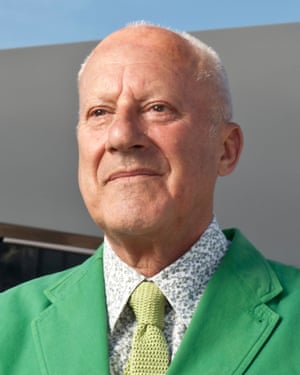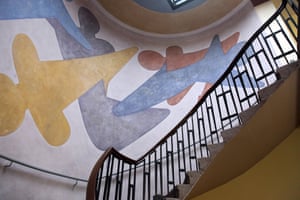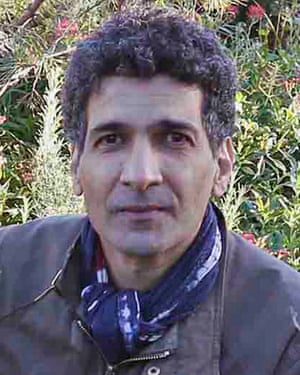Bauhaus at 100: what it means to me by Norman Foster, Margaret Howell and others
The Observer
Bauhaus
As the influential design school turns 100, architects, designers and other creatives talk about how its ideas have shaped their work
• Rowan Moore on the enduring appeal of Bauhaus
The Observer
Sun 20 Jan 2019 09.00 GMT
 Illustration: Lynsey Irvine for the Observer
Illustration: Lynsey Irvine for the Observer
Daniel Libeskind: ‘My professor was Bauhaus-taught, so I had the real thing’
Polish-American architect best known for the Jewish Museum in Berlin
I went to school in New York, to the Cooper Union, and many of my teachers were Bauhaus refugees. Prof Hannes Beckmann, for example, who taught me colour theory and design, was a Bauhaus-taught painter and photographer, and was teaching us from the notes of Wassily Kandinsky and Paul Klee. Can you believe it? He showed me their notes with the comments by these amazing artists on them.
So I had the exact course that was taught at the Bauhaus and I learned the beauty and profundity of its ideas. Sometimes Beckmann would correct us using the words of Kandinsky, which I learned later reading his books. I think I was lucky to have been given an extended Bauhaus education through the refugees in New York. I would never have done what I do without that.
Also, when I moved from Poland to Israel in the 1950s, Tel Aviv was a Bauhaus city, made by architects who came [from Germany] to Palestine and so that gave me a sense of the Bauhaus intellectually and in terms of city planning. It was beautiful living there; the ideas work perfectly. The city was low rise at that time, nothing more than four storeys high; buildings were raised above the ground to make way for car entry and they had little gardens. It was the ideal city, but cities grow and Tel Aviv today is very different.
Bauhaus, at its core, is about understanding the world and its wonder. It’s the fact that everything to do with design – from the small to the large to the horizon – is something beautiful and worthy of the word wonder.
Sign up to the Art Weekly email
Read more
I think Bauhaus has a strong ethical and political dimension – it strives for equality. It was only later on that it became minimalist and reductivist in its ideas. The true, original Bauhaus was about the eternal human spirit. I think the Bauhaus has a global impact – in Russia, the United States, Japan – because of what it sought to do – to illuminate the world of design with powerful concepts and the notion of beauty. It was to get rid of the junk, the accretions of time, to clear up the environment and see how it could be designed in a way that was not just functional but created a community.
For the centenary, I would invite people to think that Bauhaus hasn’t ended, to think about its architects and designers and what they might be doing today. Certainly not the work they did in the 20s. It’s a style for the future; its lessons are to do with transformation of form – transformation of status and design to become socially important in the world.

Michael Craig-Martin: ‘It’s only half joking to say that Ikea is the realisation of the Bauhaus dream’
Artist and influential teacher of the YBA generation in the 1980s
In a sense, the Bauhaus represents the 20th century – it defined our whole idea of what it is to be modern. What a radical idea it was for a school: this relationship between art and design, architecture, between furniture, graphics, painting, sculpture. Bauhaus tried to bring them all together and, in a true modernist sense, create a utopia. It’s interesting that many of the things they designed were very difficult for them to actually produce. So much of what they did really only became available to people in the 50s and 60s when the techniques for fabrication made it possible – they were so ahead of their time that although these things were meant to be mass-produced, they were unable to at the time.
I became particularly interested in the Bauhaus [when I was studying] at Yale because of Josef Albers, who taught there for 10 years. I was struck by Albers’s very intelligent use of the visual. Sometimes people talk about the intellect and emotion as though the two are separate – it was very much a Bauhaus idea to bring them together. Everything they did was to maximise a kind of directness, economy, clarity. These are the things I see in my own work that I would trace directly back to Bauhaus ideas. And also the idea of the elevation of ordinary life, that it’s worth taking seriously how an object looks, in order to make it efficient and at the same time beautiful.

FacebookTwitterPinterest Detail of the staircase at Haus Feininger, one of the four surviving Meisterhäuser in Dessau. Photograph: Alamy
So I was carrying something of the Bauhaus with me when I started teaching at Goldsmiths. I think the idea that there is some kind of connectedness between these traditions of art schools is very touching. Albers always thought that when it came to what an artist did in the studio, the most important relationship was between artists and their work: the artist and their individual sense, and what it is that they produced through their own sensibility. That’s something you see reflected in the YBAs.
Advertisement
The way things are going, it could be that even in another 100 years people will still think of Bauhaus as representing the modern. It’s only half-joking to say that Ikea is the realisation of the Bauhaus dream: good, simple design, available at very modest prices to everybody. Perhaps more today than in the immediate past, there’s a conjunction between ideas in architecture, furniture design, art – the boundaries between different disciplines have softened a great deal. The things that the Bauhaus hit on and developed through the years went right to the heart of the design of things, the nature of things. They got it so accurately that it has never been truly displaced.

Norman Foster: ‘The lasting influence of Bauhaus is not stylistic, but the attitude of mind it cultivated’
Prize-winning architect whose buildings include the Gherkin and the Reichstag
Very often, inspiration arrives subliminally, lying hidden to be discovered many years later, or perhaps never. Other influences are more direct; we can acknowledge them at the time and see clearly the impression they leave on our lives. Working in Manchester from the age of 16 to 18, I spent most lunch breaks wandering around buildings in the city. I wasn’t aware that some day I might be an architect. I was just drawn to buildings. Some buildings and parts of that city were particularly inspirational – the cast-iron structure of the Barton Arcade, the Victorian architecture of Manchester town hall, the modernism of the Daily Express building. There is another, more modest building which changed my life forever. This was my local lending library, built in 1903, in one of Manchester’s working-class suburbs. There, as a youth, I discovered books by Le Corbusier and the work of other modern architects such as Frank Lloyd Wright as well as the Bauhaus. So I discovered Bauhaus through my local library before becoming a student at Manchester University. When I moved to Yale as a postgraduate, I was taught by Paul Rudolph, who had studied under Walter Gropius at Harvard, so for me there is a direct lineage.
I have a passionate interest in the links between architecture, design and art, which were at the core of the Bauhaus philosophy. There is also my driving curiosity about how things are made, which is mirrored in the term “Bauhaus” when it is taken in the sense of “the School of Building”, which it was at the time.
The Bauhaus was one of the birthplaces of the modern world. It provided a utopian vision and a forward-looking worldview. Gropius envisioned a time when buildings would be mass-produced in factories and their component parts assembled on site – he designed cars, trains and, with Konrad Wachsmann, experimented with modular systems for housing.
As technology and materials have advanced, this thinking is even more relevant. From the beginning of my career, I have encouraged the use of prefabricated components and we have worked at the scale of prefabricating entire buildings. The potential for three-dimensionally printing a building is arguably an extension of the Bauhaus philosophy. I am particularly interested in how these methods could be used to improve the quality of life in some of the world’s poorest communities.

FacebookTwitterPinterest Bauhaus director Walter Gropius’s students poke fun at his minimalist design for living ideas in this 1927 photograph by Edward Curtis. Photograph: Michael Hoppen Gallery
Advertisement
I recently had the pleasure of visiting a work by the founder of the Bauhaus, Walter Gropius – his house in Lincoln, Massachusetts. Gropius’s tenure at Harvard was arguably a transformative force in contemporary American architecture and changed the face of Boston and nearby Cambridge with a new wave of modernism. His house, completed in 1942, is a fusion of the Bauhaus ideals and is a masterpiece.
The lasting influence of Bauhaus is not stylistic, but the attitude of mind it cultivated. In fact, perhaps the worst thing about Bauhaus are the bad copies of design classics from that period – fashion over substance. Bauhaus at its best was a revolution in the relationship between arts and crafts, aesthetics and functions, conceiving and making.

Margaret Howell: ‘The practice of combining design with manufacturing was inspirational’
Fashion designer with a minimalist clothing line using British materials
Probably the Bauhaus had the biggest influence on me in my first year of art school. The coming together of different disciplines and the practice of combining design with manufacturing was inspirational, imaginative, experimental and, above all, a break with the past. Lucky were the students to have practising teachers such as Walter Gropius, Marcel Breuer, Josef Albers and Paul Klee.
A wealth of black-and-white photographs exists that capture the energy and spirit of those students – they are alive with creativity. Often shot with unconventional angles, girls with short haircuts and casual clothes, the look and mood of these photographs inspired me when designing clothes. They embodied a style that reflects an active working life and an equality of outlook.
I recently visited the Bauhaus in Dessau as it was being renovated. A heap of chrome, cantilever chairs sat outside; inside, there were empty studios, corridors and staircases in the process of being repainted white with areas of selected colour. It was exciting to see the building empty and to imagine the life and creativity that went on there. Posters of past exhibitions were lying in an open chest – bold graphics that still looked fresh. I bought a couple and now wish I had bought them all.

Simon Mawer: ‘Bauhaus was very much about internationalism’
Author of the 2009 Booker prize-nominated novel of architecture The Glass Room
I first visited Mies van der Rohe’s Villa Tugendhat in the Czech city of Brno in the 1990s. In those days it was very difficult to get into it as a tourist: the iron curtain had only just come down and the mentality hadn’t. There was a slightly run-down air to it back then, but walking down the staircase into the living room was literally breathtaking – at least for me. I gasped. It was like walking into a work of art.
That visit, and a second one 10 years later, made me think, “There’s a novel here.” Not the story of the family who actually lived there, but the story of my family, a family that I would eventually create in my novel The Glass Room.
I love the aesthetic, but Bauhaus was also very much making a statement about internationalism. Of course, knowing the history, one knew how ghastly it was going to be in less than 20 years. To build something like Villa Tugendhat in 1928 in the centre of Europe was a wonderful symbol of light and breaking down barriers. And the world all around them was at that moment extinguishing light and building up barriers. So it became very much a source of inspiration.

Jonathan Barnbrook: ‘My work became a crusade against everything that was functional’
British graphic designer and typographer best known for his work with David Bowie and Damien Hirst
The Bauhaus has always dominated my design thinking. Initially, I was absolutely against everything it stood for. As you do when you’re young, my work became a crusade against everything that was “functional”. I immersed myself in postmodernist theorists such as Jean-François Lyotard and playful design groups such as Memphis, creating layouts that were intentionally illegible and full of decoration for the sake of it.
Then, as I got older, something happened. Tired of excess and decoration being used to sell the same old stuff, I started to do the opposite: strip everything down to the basic form, let an idea come through. I understood that within the framework of the Bauhaus there was still space for humanity – I had just chosen to ignore it when I was younger.
The cover I designed for Bowie’s The Next Day was probably the most extreme example of this newfound appreciation. A simple obscuring of an old cover with a white square, but something that caused argument and debate when it came out.
The Bauhaus is as important to me now as it was when I first started. I retain the spirit that the world would be a very boring place if everything was well designed, but In a world where most things are badly designed, everybody should learn the theories of Bauhaus before they are allowed to touch a computer.
As for the legacy, I do think that the most prominent expression we have nowadays is not in art schools or rarefied museums – it is Ikea. Furniture made with simple production methods that is accessible to all affordable and has a simple, clean aesthetic. I am pretty sure Gropius et al would be rather happy about that.

Linda Grant: ‘The city of Tel Aviv was a political metaphor’
British novelist, journalist and writer fascinated by Bauhaus
Twenty years ago, in 1998, I went to Tel Aviv to write an article for the Guardian on the 50th anniversary of the state of Israel. The place was very run-down in the late 1990s, before it was designated a Unesco world heritage site. At first I thought it was made up of a lot of decaying 60s buildings. Then, looking closer, I recognised the curved lines and clean, geometric shapes and realised the entire fabric of the city was Bauhaus. I discovered that the architects who had designed and built the city were refugees who had trained at the Bauhaus in Germany and fled from Nazi persecution in the 30s to what was then British Mandatory Palestine. Once there, they found such a huge demand for housing from others fleeing Europe that they built an entire Bauhaus city in less than a decade. I found that extraordinary and deeply moving. It seemed to me that the whole architecture of the city was a political metaphor, which was a jolt to the heart as well as the brain. I started wondering about the individuals who had financed and built the buildings, people fleeing for their lives and bringing with them the best of Europe to help them begin again in the supposedly backward Middle East. As well as previously unheard-of fitted kitchens, they created wonderful communal areas in their buildings, restaurants and nurseries, where people could share their lives. There was a heartbreaking idealism about it all.
The trip inspired my book When I Lived in Modern Times, which is set in Tel Aviv in the 1940s. The fascination has stayed with me. My most recent book, The Dark Circle, is set in a sanatorium built by a German émigré, so I am still creating fictional Bauhaus settings for my novels.

Samuel Ross: ‘The Bauhaus carved out a new dialogue across design theory and aesthetics’
Designer of A-Cold-Wall* menswear label and the winner of the 2018 fashion award for British emerging menswear designer
The Bauhaus school of thought has had much influence in shaping 20th-century architecture and, in turn, sculpting our individual interactions. I first encountered Bauhaus design aged 14, at an open day for my father’s MA course at Central Saint Martins. I remember the faculty archive had a selection of Bauhaus-inspired objects – teapots, cups, objects of that nature.
Now, my favourite work is Josef Albers’s study into colour theory. Albers’s art works and furniture live in the space between design and art. The Bauhaus’s focus on multifaceted ideation and execution carved out a new dialogue across design theory and aesthetics that became the blueprint for my generation’s newfound freedom.
Designers, artists and sculptors who I believe embody this notion (more so in their philosophy and theory than their aesthetic) include Noirwave artist Rharha [Rochelle Nembhard], fashion designer Virgil Abloh, designer Jobe Burns, musician Petite Noir, furniture designer Dozie Kanu and the painter Reginald Sylvester II. It’s the tone, physicality and voice of this generation.

Dexter Dalwood: ‘Yamamoto could never have created the Ziggy Stardust costumes without Oskar Schlemmer’
British artist whose collages and painting have been exhibited at the Tate and Saatchi. He was a Turner prize nominee in 2010 and his next show is at Simon Lee Gallery in February
My introduction to Bauhaus was at school, through The Story of Art by EH Gombrich. He wrote: “Bauhaus got rid of the tasteless knick-knackery of the 19th century and streamlined design for the 20th century”, which I really liked. Then, I only thought about it in terms of modern architecture rather than painting. What I like about it now is the radical, intellectual seriousness and commitment to art education. For my work, the Bauhaus was influential in the developement of modern art and modern thought. I’m not into it as the hardcore root of modern abstractionism, but it was vital for the idea of looking as an intellectual pursuit.

FacebookTwitterPinterest A dancer from the Triadic Ballet, developed in 1922 by Bauhaus teacher Oskar Schlemmer, who also designed the costumes. Photograph: Getty Images
I really like Marcel Breuer’s Pirelli Tire Building in New Haven and Naum Gabo’s Linear Construction No 2, but one of my favourite Bauhaus paintings is by Oskar Schlemmer, Bauhaus Stairway (1932). I love how wacky his designs were. Kansai Yamamoto would never have created the Ziggy Stardust costumes for David Bowie without Schlemmer. Bauhaus’s legacy isn’t set, though, its reputation has changed with art history revisionism in a good way. We’re revising who the most important mid-century artists are, now that those who were famous are less respected. just look at Anni Albers at Tate Modern. It’s good that it has endured; after all, as Keats said, “A thing of beauty is a joy forever”.

Hans Ulrich Obrist: ‘It’s important to paint a truer picture of the Bauhaus within the brutal politics of its time’
Swiss curator, critic and artistic director of the Serpentine Galleries, London
When I was a teenager in Zurich, there was an exhibition called The Tendency Towards the Total Work of Art curated by Harald Szeemann. It ran from February to April in 1983 and I went to see it 41 times. It was part of my inspiration to work in the arts and become a curator. It was a non-didactic attempt to create, as Szeemann said, “poems in space”. That was, somehow, the moment that art became a passion, something more intense. I also visited the Weissenhofsiedlung in Stuttgart at that time. It’s a housing estate conceived as an international showcase of what became the international style of modern architecture. It was built for an exhibition in 1927 and the 33 buildings include 63 living units designed by 17 architects. It made me want to curate architecture. I also took away the idea that while it’s good to visit exhibitions, it’s interesting to look at buildings. I would love to live in the Weissenhofsiedlung – what an experience that would be.
The centenary is now, but which Bauhaus are you celebrating? As Eric Hobsbawm said, we need a protest against forgetting. It’s important to celebrate its achievements, but it’s also important, as the writer Alice Rawsthorn points out in her extraordinary Instagram account, to paint a truer picture of the Bauhaus within the brutal and tragic politics of its time, to address the misogyny of the early years and the accusations of Nazi collusion in the later years. Although we have a mine of information in the digital age, that doesn’t mean we remember more. I hope that we can focus on the more forgotten aspects of the school. Hannes Meyer, the school’s second director, deserves wider recognition. He was very interested in collective architecture, and if you look at the architecture world now, there are so many collectives.
Johannes Itten is better known, but there’s such a current interest in technology and spirituality, revisiting him would be interesting. Lotte Stam-Beese and other women of the Bauhaus have not been remembered as they should. Stam-Beese was extraordinary – an urbanist, she planned whole cities in Ukraine and Holland.
The Bauhaus was much more than a design school and, although it wasn’t open long, it was during an intense moment of history and that intensity has resonated through the generations.

Eva Franch i Gilabert: ‘Both schools ask how do we want to live together?’
Spanish architect and first permanent female director of the prestigious Architectural Association school in London
The Bauhaus did in the early 20s what many schools and institutions are unable to do today: consider every single act of life as a space of design and creative action. Over the years, I’ve organised many projects that resonated with the spirit of Bauhaus. The Architectural Association, like the Bauhaus, is a place where daring, creative thinking and risk-taking are basic attitudes towards learning and making. Both schools aim to answer one simple, yet large, question: how do we want to live together?
Answering this goes beyond studios, workshops and seminars and includes a creative life of talks, discussions, parties and events. While the musician Andor Weininger created the “fun department” in the Bauhaus in the 20s, the AA today has its “party committee” [to help] push the school community to explore, discuss and debate beyond boundaries.

FacebookTwitterPinterest Mural done by Oskar Schlemmer in 1923 for the Bauhaus School of Arts and Crafts. Photograph: Loop Images/UIG via Getty Images
The Bauhaus dealt with issues of housing, affordability and global aesthetics; the AA today faces the same issues with an added set of complex challenges including sustainability, technology and inequality in a local but also in a global context. I hope that a renewed interest in the Bauhaus and its methods will inspire us all. We all need more rigour – and more fun.

Willo Perron: ‘It’s the closest I know to an art and design utopia’
Designer, founder of Willo Perron & Associates design studio, who works as creative director for St Vincent, Drake and Kanye West
Bauhaus is complete. It’s the closest version I know of an art and design utopia, never negating any creative field. From architecture to theatre, dance to scenic design, costuming to typography, everything was built around a community and around the idea of sharing thoughts and information. There isn’t a single piece of work that I could pick as a favourite; the idea I love about Bauhaus is the inclusiveness of all mediums.

Amin Taha: ‘Its legacy should be taught at all schools’
Architect who worked with Zaha Hadid before setting up his own studio. Creator of the RIBA-award-winning 15 Clerkenwell Close
The Bauhaus, for me, is characterised by its seminal Dessau period where modernism aligned with Walter Gropius’s and Henry van der Velde’s original plan to bring together art and technical colleges under William Morris’s socialist and design ideals. The move to Dessau happened after the school was compelled for political reasons to leave Weimar, where it was seen as a hotbed of communists and it lost its funding.
Dessau is where the Bauhaus became self-sufficient under the new head Hannes Meyer, by creating products and practising architecture in the town – including Dessau’s iconic buildings. Nazi elections saw it evacuate to Berlin, but the capital was soon loyal to the party. The school’s final head, Mies van der Rohe, called the students and tutors together and, over bottles of champagne, he told all to leave the country.
Van der Rohe and others went to America, changing it and architecture for ever – leaving Tom Wolfe forlorn enough to write From Our House to Bauhaus. The legacy of the school’s short but remarkable 14 years of existence is its liberal and plural teaching of determination to follow through and develop ideas. It’s a legacy that should be taught at all schools, to all students and to practising architects.
沒有留言:
張貼留言